内容
try: # 以绝对导入的方式导入cofig对象,并获取其{model_name}Config!
config = getattr(importlib.import_module('config'), f"{model_name}Config")
except AttributeError:
print(f"{model_name} not included!")
exit()
这里就是config下的属性类
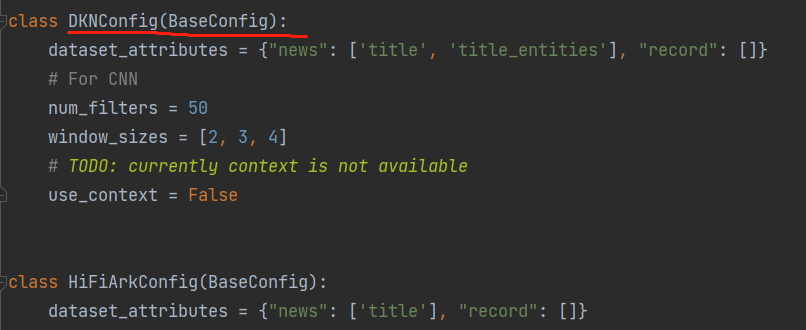
下面是解析behavior.tsv文件, behavior.tsv文件如下;

这就是user-1的clicked News

共有五列: 分别是’impression_id’, ‘user’, ‘time’, ‘clicked_news’, ‘impressions’! 但是文件中没有给出列明的,需要自己来定义!
下面是解析后的behavior_parsed.tsv文件:

def parse_behaviors(source, target, user2int_path):
"""
Parse behaviors file in training set.
Args:
source: source behaviors file
target: target behaviors file
user2int_path: path for saving user2int file
"""
print(f"Parse {source}")
behaviors = pd.read_table(
source,
header=None,
names=['impression_id', 'user', 'time', 'clicked_news', 'impressions'])
behaviors.clicked_news.fillna(' ', inplace=True) #使用空格来填充缺失值,并修改原文件
behaviors.impressions = behaviors.impressions.str.split() #以空字符为分隔符来切分字符串,并返回list列表,没有指定num,所以是全部分割
user2int = {} #定义空字典,用于存储用户转为索引
for row in behaviors.itertuples(index=False): #将DataFrame转换为tuple并访问每行
if row.user not in user2int: #如果该用户没有在字典中
user2int[row.user] = len(user2int) + 1 #usr2int["U87243"] = 0 + 1,也就是给定索引,记得是从1开始的,不是从0!
#最普通的创建DataFrame方法,其中data = user2int.items(),是元组数组; index自动; columns = user 和 int
#将该DataFrame转换为csv文件, 分隔符是"\t",一个tab! 不保留原来的索引
pd.DataFrame(user2int.items(), columns=['user',
'int']).to_csv(user2int_path,
sep='\t',
index=False)
print( #处理完数据了,看看有多少有效的user_int
f'Please modify `num_users` in `src/config.py` into 1 + {len(user2int)}'
)
#获取了df矩阵中底index行,第'user'列! 也就是将用户名改成index
for row in behaviors.itertuples():
behaviors.at[row.Index, 'user'] = user2int[row.user]
#进度条展示! 名字是Balancing data,遍历的是整个文件
for row in tqdm(behaviors.itertuples(), desc="Balancing data"):
positive = iter([x for x in row.impressions if x.endswith('1')])
negative = [x for x in row.impressions if x.endswith('0')]
random.shuffle(negative)
negative = iter(negative)
pairs = []
try:
while True:
pair = [next(positive)]
for _ in range(config.negative_sampling_ratio):
pair.append(next(negative))
pairs.append(pair)
except StopIteration:
pass
behaviors.at[row.Index, 'impressions'] = pairs
behaviors = behaviors.explode('impressions').dropna(
subset=["impressions"]).reset_index(drop=True)
behaviors[['candidate_news', 'clicked']] = pd.DataFrame(
behaviors.impressions.map(
lambda x: (' '.join([e.split('-')[0] for e in x]), ' '.join(
[e.split('-')[1] for e in x]))).tolist())
behaviors.to_csv(
target,
sep='\t',
index=False,
columns=['user', 'clicked_news', 'candidate_news', 'clicked'])
补充:
1. getattr()函数
-
描述
getattr() 函数用于返回一个对象的属性值。 -
语法
getattr(object, name[, default]) -
参数
object – 对象。
name – 字符串,对象属性。
default – 默认返回值,如果不提供该参数,在没有对应属性时,将触发 AttributeError -
返回值
返回对象属性值 -
实例
>>>class A(object):
... bar = 1
...
>>> a = A()
>>> getattr(a, 'bar') # 获取属性 bar 值
1
>>> getattr(a, 'bar2') # 属性 bar2 不存在,触发异常
Traceback (most recent call last):
File "<stdin>", line 1, in <module>
AttributeError: 'A' object has no attribute 'bar2'
>>> getattr(a, 'bar2', 3) # 属性 bar2 不存在,但设置了默认值
3
>>>
实例2:
>>> class A(object):
... def set(self, a, b):
... x = a
... a = b
... b = x
... print a, b
...
>>> a = A()
>>> c = getattr(a, 'set')
>>> c(a='1', b='2')
2 1
>>>
实际的实例:
try:
config = getattr(importlib.import_module('config'), f"{model_name}Config")
except AttributeError:
print(f"{model_name} not included!")
exit()
2. importlib.import_module()
这样做的目的就是为了动态的引入模块!
import importlib
params = importlib.import_module('b.c.c') #绝对导入 在同一文件夹下则不同b了
params_ = importlib.import_module('.c.c',package='b') #相对导入
3. f-strings 字符串格式化
这种在字符串前面加“f”就相当于 “XX{ }”.format(model_name)
举例:
name = '宝元'
age = 18
sex = '男'
msg1 = F'姓名:{name},性别:{age},年龄:{sex}' # 大写字母也可以
msg = f'姓名:{name},性别:{age},年龄:{sex}' # 建议小写
print(msg)
4. pd.read_table()
原代码中是header和names混合使用! 如果header = None; names就该设置列明
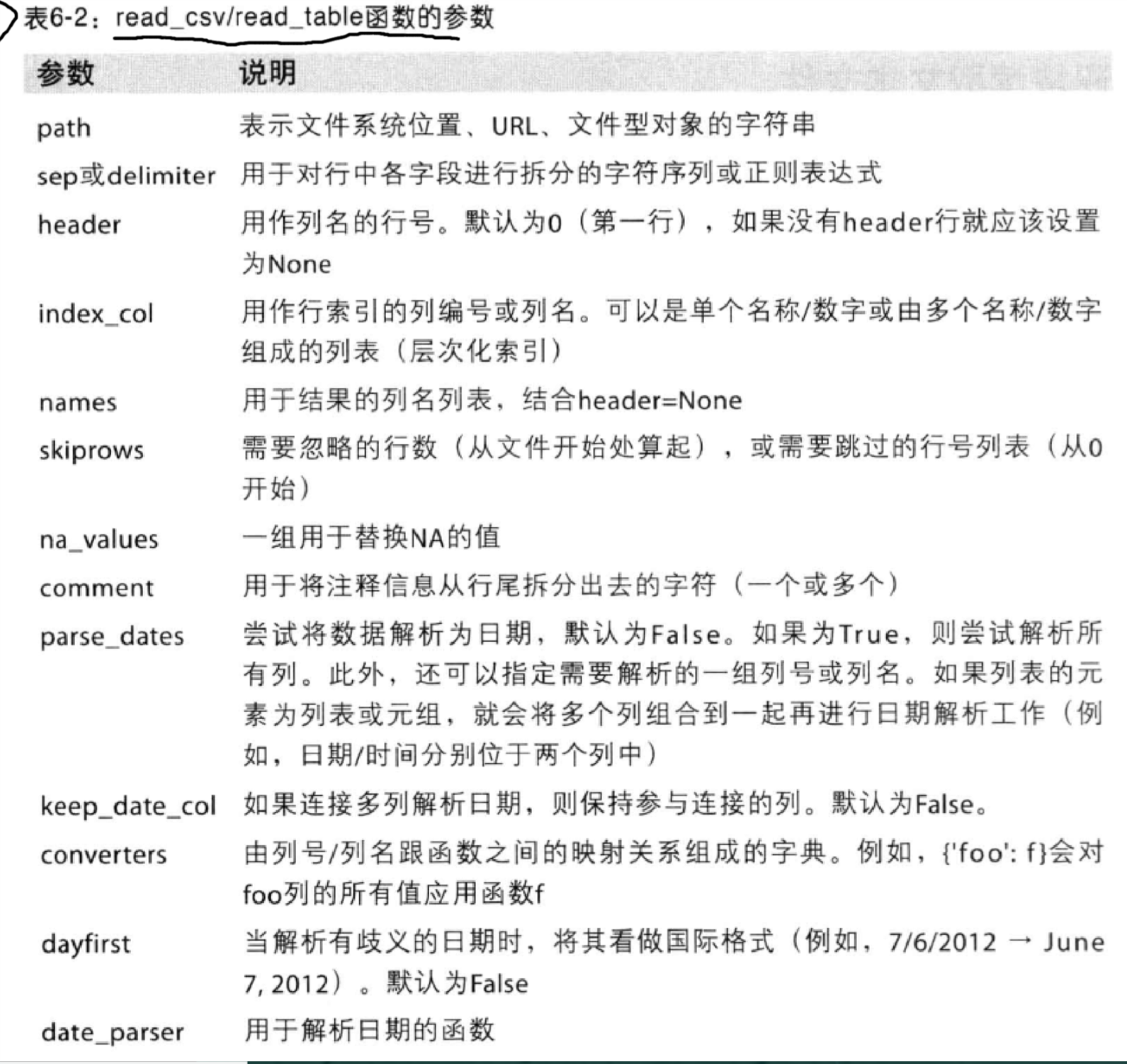

5. fillna()函数
具体请参考博文
我只摘录和原代码相关的内容!
该函数用来填充缺失值! 也就是NaN!
- inplace: 方法有改变原文件也有不改变原文件两种方式! 不改变原文件顾名思义也就是创建临时对象,只有在运行程序时有一个对象,相反,则是把原文件改了! 该
- 填充值
#二、指定inplace参数
print (df1.fillna(0,inplace=True))
print ("-------------------------")
print (df1)
使用0来填充,那么源代码就是使用" " 空格来填充
6. split()方法
-
描述:
str.split() 通过指定分隔符对字符串进行切片,如果参数 num 有指定值,则分隔 num+1 个子字符串 -
语法:
split() 方法语法:
str.split(str="", num=string.count(str)).
-
参数:
str – 分隔符,默认为所有的空字符,包括空格、换行(\n)、制表符(\t)等。
num – 分割次数。默认为 -1, 即分隔所有。(从第一个分隔符开始切分) -
返回值
返回分割后的字符串列表。(list列表) -
实例
>>>str = "Line1-abcdef \nLine2-abc \nLine4-abcd";
>>>print str.split( ); # 以空格为分隔符,包含 \n,如果为空的话,那么就是所有空字符
>>>print str.split(' ', 1 ); # 以空格为分隔符,分隔成两个
['Line1-abcdef', 'Line2-abc', 'Line4-abcd']
['Line1-abcdef', '\nLine2-abc \nLine4-abcd']
- 实例2
以下实例以 # 号为分隔符,指定第二个参数为 1,返回两个参数列表。
#!/usr/bin/python
# -*- coding: UTF-8 -*-
txt = "Google#Runoob#Taobao#Facebook"
# 第二个参数为 1,返回两个参数列表
x = txt.split("#", 1)
print x
7. iteritems()、 iterrows()、itertuples():
itertuples()
原博客
这是将原DataFrame转成一行一行的tuple,也就是小DataFrame!
如果我们想访问要和getattr结合!
举例:
假如原test是这样的!
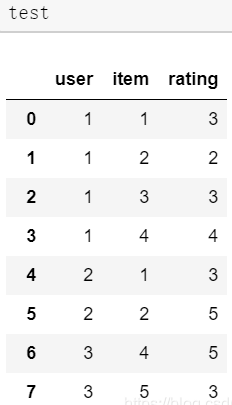
当我们运行itertuples()时:
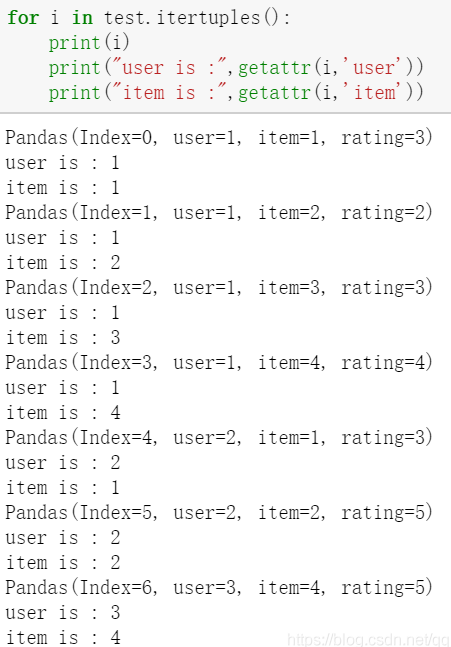
其它的请看链接,我暂时不需要
8. pd.DataFrame()
也就是创建DataFrame()
DataFrame是由多种类型的列构成的二维标签数据结构.[1]
往往包含index(行标签)和columns(列标签), 彼此独立, 互不影响
直观理解:DataFrame 是带标签的二维数组
所以问题在于如何创建DataFrame:
最普通的创建DataFrame
DataFrame()函数的参数index的值相当于行索引,若不手动赋值,将默认从0开始分配。columns的值相当于列索引,若不手动赋值,也将默认从0开始分配。
data = {
'性别':['男','女','女','男','男'],
'姓名':['小明','小红','小芳','大黑','张三'],
'年龄':[20,21,25,24,29]}
df = pd.DataFrame(data, index=['one','two','three','four','five'],
columns=['姓名','性别','年龄','职业'])
df
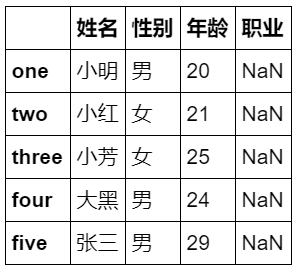
df.values 返回ndarray类型的对象
ndarray类型即numpy的 N 维数组对象,通常将DataFrame类型的数据转换为ndarray类型的比较方便操作。如对DataFrame类型进行切片操作需要df.iloc[ : , 1:3]这种形式,对数组类型直接X[ : , 1:3]即可。
X = df.values
print(type(X)) #显示数据类型
X
运行结果:
<class 'numpy.ndarray'>
[['小明' '男' 20 nan]
['小红' '女' 21 nan]
['小芳' '女' 25 nan]
['大黑' '男' 24 nan]
['张三' '男' 29 nan]]
df.iloc[ 行序,列序 ] 按序值返回元素
df.iloc[1,1]
Index(['one', 'two', 'three', 'four', 'five'], dtype='object')
df.at[index, columns]
作用:获取某个位置的值,例如获取第0行,第a列的值,即:index=0, columns = ‘a’
data = df.at[0, ‘a’]
9. items()
描述
Python 字典(Dictionary) items() 函数以列表返回可遍历的(键, 值) 元组数组。
语法
dict.items()
参数
无
返回值
返回可遍历的(键, 值) 元组数组 (不是list,而是数组)
实例
#!/usr/bin/python
# coding=utf-8
dict = {'Google': 'www.google.com', 'Runoob': 'www.runoob.com', 'taobao': 'www.taobao.com'}
print "字典值 : %s" % dict.items()
# 遍历字典列表
for key,values in dict.items():
print key,values
字典值 : [('Google', 'www.google.com'), ('taobao', 'www.taobao.com'), ('Runoob', 'www.runoob.com')]
Google www.google.com
taobao www.taobao.com
Runoob www.runoob.com
10. .to_csv()
1.首先查询当前的工作路径:
import os
os.getcwd() #获取当前工作路径
2.to_csv()是DataFrame类的方法,read_csv()是pandas的方法
dt.to_csv() #默认dt是DataFrame的一个实例,参数解释如下
- 路径 path_or_buf: A string path to the file to write or a StringIO
dt.to_csv('Result.csv') #相对位置,保存在getwcd()获得的路径下
dt.to_csv('C:/Users/think/Desktop/Result.csv') #绝对位置
- 分隔符 sep : Field delimiter for the output file (default ”,”)
dt.to_csv('C:/Users/think/Desktop/Result.csv',sep='?')#使用?分隔需要保存的数据,如果不写,默认是,
- 替换空值 na_rep: A string representation of a missing value (default ‘’)
dt.to_csv('C:/Users/think/Desktop/Result1.csv',na_rep='NA') #确实值保存为NA,如果不写,默认是空
- 是否保留行索引 index: whether to write row (index) names (default True)
dt.to_csv('C:/Users/think/Desktop/Result1.csv',index=0) #不保存行索引
- 是否保留列名 header: Whether to write out the column names (default True)
dt.to_csv(‘C:/Users/think/Desktop/Result.csv’,header=0) #不保存列名
- 是否保留某列数据 cols: Columns to write (default None
dt.to_csv('C:/Users/think/Desktop/Result.csv',columns=['name']) #保存索引列和name列
11. tpdm(iterator)
Tqdm 是一个快速,可扩展的Python进度条,可以在 Python 长循环中添加一个进度提示信息,用户只需要封装任意的迭代器 tqdm(iterator)。
使用pip就可以安装。
- 参数:
iterable=None, 当然是我们要被迭代的对象! 迭代多少次,则显示多少
desc=None, 传入str类型,作为进度条标题(类似于说明)
total=None, 预期的迭代次数
leave=True,
file=None,
ncols=None, 可以自定义进度条的总长度
mininterval=0.1, 最小的更新间隔
maxinterval=10.0, 最大更新间隔
miniters=None,
ascii=None,
unit='it',
unit_scale=False,
dynamic_ncols=False,
smoothing=0.3,
bar_format=None,
initial=0,
position=None,
postfix 以字典形式传入 详细信息 例如 速度= 10,
- 操作1:
from tqdm import tqdm
for i in tqdm(range(10000)):
"""一些操作"""
pass

操作2:
dict = {"a":123,"b":456}
for i in tqdm(range(10),total=10,desc = "WSX",ncols = 100,postfix = dict,mininterval = 0.3):
pass

操作3
from tqdm import trange
from random import random, randint
from time import sleep
with trange(100) as t:
for i in t:
# Description will be displayed on the left
t.set_description('下载速度 %i' % i)
# Postfix will be displayed on the right,
# formatted automatically based on argument's datatype
t.set_postfix(loss=random(), gen=randint(1,999), str='详细信息',
lst=[1, 2])
sleep(0.1)

其中trange(i) 是 tqdm(range(i)) 的简单写法